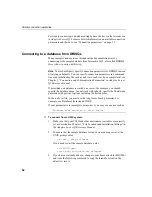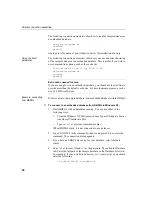
Simple connection examples
58
The following connection parameters show how to load the sample database as
an embedded database:
dbf=path\asiqdemo.db
uid=dba
pwd=sql
where path is the name of your Adaptive Server IQ installation directory.
Using the Start
parameter
The following connection parameters show how you can customize the startup
of the sample database as an embedded database. This is useful if you wish to
use command-line options, such as the cache size:
Start=asiqsrv12 -gm 10 -gp 4096 -c 8M
dbf=path\asiqdemo.db
uid=dba
pwd=sql
Extra cache needed for Java
If you are using Java in an embedded database, you should use the start line to
provide more than the default cache size. For development purposes, a cache
size of 8 MB is sufficient.
Example: connecting
from DBSQL
In this example, the sample database is an embedded database within DBSQL.
❖
To connect to an embedded database from DBSQL in Windows NT:
1
Start DBISQL with no databases running. You can use either of the
following ways:
•
From the Windows NT Start menu, choose Sybase
→
Adaptive Server
Anywhere
→
Interactive SQL.
•
Type
dbisql
at a system command prompt.
When DBISQL starts, it is not connected to any database.
2
Type CONNECT in the command window, and press F9 to execute the
command. The connection dialog appears.
3
If you have an ODBC data source for your database, select that data
source.
4
Enter
DBA
as the user ID and
SQL
as the password. Then click the Database
tab. Enter the full path of the sample database in the Database File field.
For example, if your installation directory is c:\sybase\asiq12 you should
enter the following:
c:\sybase\asiq12\asiqdemo.db
Summary of Contents for Adaptive Server IQ 12.4.2
Page 1: ...Administration and Performance Guide Adaptive Server IQ 12 4 2 ...
Page 16: ...xvi ...
Page 20: ...Related documents xx ...
Page 40: ...Compatibility with earlier versions 20 ...
Page 118: ...Troubleshooting startup shutdown and connections 98 ...
Page 248: ...Importing data by replication 228 ...
Page 306: ...Integrity rules in the system tables 286 ...
Page 334: ...Cursors in transactions 314 ...
Page 396: ...Users and permissions in the system tables 376 ...
Page 438: ...Determining your data backup and recovery strategy 418 ...
Page 484: ...Network performance 464 ...
Page 500: ...System utilities to monitor CPU use 480 ...
Page 514: ...Characteristics of Open Client and jConnect connections 494 ...
Page 536: ...Index 516 ...
















































